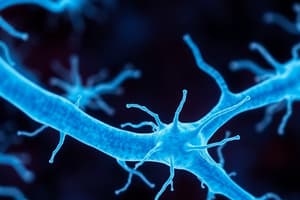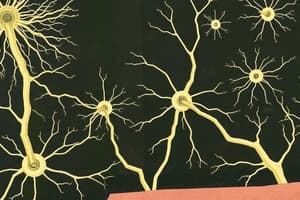Podcast
Questions and Answers
What is the primary role of astrocytes in the nervous system?
What is the primary role of astrocytes in the nervous system?
- Act as immune cells against pathogens
- Form myelin sheaths in the CNS
- Regulate the chemical environment around neurons (correct)
- Remove cellular debris in the brain
Which glial cells are responsible for myelination in the peripheral nervous system?
Which glial cells are responsible for myelination in the peripheral nervous system?
- Schwann Cells (correct)
- Astrocytes
- Oligodendrocytes
- Microglia
What factor primarily contributes to the variation in neuron size and shape?
What factor primarily contributes to the variation in neuron size and shape?
- The presence of myelin sheaths
- The specific function of the neuron (correct)
- The age of the organism
- The chemical environment of the neurons
Which of the following functions is NOT coordinated by neurons?
Which of the following functions is NOT coordinated by neurons?
Which type of glial cells act as immune cells in the central nervous system?
Which type of glial cells act as immune cells in the central nervous system?
What is the primary function of neurons?
What is the primary function of neurons?
Which type of neuron transmits sensory information to the central nervous system?
Which type of neuron transmits sensory information to the central nervous system?
What component of a neuron is responsible for receiving signals?
What component of a neuron is responsible for receiving signals?
Which structure in neurons increases the speed of signal transmission?
Which structure in neurons increases the speed of signal transmission?
What role do interneurons play in the nervous system?
What role do interneurons play in the nervous system?
Which of the following neurotransmitters is involved in regulating mood?
Which of the following neurotransmitters is involved in regulating mood?
What is the primary function of glial cells in the nervous system?
What is the primary function of glial cells in the nervous system?
What happens at the synaptic terminals of a neuron?
What happens at the synaptic terminals of a neuron?
Flashcards
What are astrocytes?
What are astrocytes?
Star-shaped cells that regulate the chemical environment around neurons by providing nutrients and removing waste products.
What do oligodendrocytes do?
What do oligodendrocytes do?
Form myelin sheaths around axons in the central nervous system, enabling faster nerve impulse transmission.
What do Schwann cells do?
What do Schwann cells do?
Form myelin sheaths around axons in the peripheral nervous system, facilitating faster nerve impulse transmission.
What are microglia cells?
What are microglia cells?
Signup and view all the flashcards
What is the main function of neurons?
What is the main function of neurons?
Signup and view all the flashcards
What are neurons?
What are neurons?
Signup and view all the flashcards
What do sensory neurons do?
What do sensory neurons do?
Signup and view all the flashcards
What do motor neurons do?
What do motor neurons do?
Signup and view all the flashcards
What are interneurons?
What are interneurons?
Signup and view all the flashcards
What is the cell body (soma) of a neuron?
What is the cell body (soma) of a neuron?
Signup and view all the flashcards
What are dendrites?
What are dendrites?
Signup and view all the flashcards
What is the axon ?
What is the axon ?
Signup and view all the flashcards
What are neurotransmitters?
What are neurotransmitters?
Signup and view all the flashcards
Study Notes
Introduction to Neurons
- Neurons are the fundamental units of the nervous system.
- Their primary function is to transmit information throughout the body in the form of electrical and chemical signals.
- They communicate with each other at specialized junctions called synapses.
Different Types of Neurons
- Sensory Neurons (afferent neurons): Transmit sensory information from the peripheral organs (e.g., skin, muscles) to the central nervous system (CNS).
- Motor Neurons (efferent neurons): Transmit signals from the CNS to muscles and glands, triggering actions.
- Interneurons: Connect sensory and motor neurons within the CNS, processing information and relaying signals, crucial for complex reflexes and higher-level cognitive functions.
Structure of a Neuron
- Cell Body (Soma): Contains the nucleus and other organelles, maintaining the neuron's life.
- Dendrites: Branching extensions that receive signals from other neurons at synapses.
- Axon: A long, slender projection that transmits signals away from the cell body to other neurons, muscles, or glands.
- Myelin Sheath: An insulating layer that wraps around some axons, increasing signal transmission speed.
- Nodes of Ranvier: Gaps in the myelin sheath, where the action potential jumps, accelerating signal speed (saltatory conduction).
- Synaptic Terminals (Axon Terminals): The end of the axon, releasing neurotransmitters to communicate with the next cell.
Neurotransmitters
- Neurotransmitters are chemical messengers that transmit signals across synapses.
- Diverse types of neurotransmitters exist, each with specific effects on target cells.
- Examples include dopamine, serotonin, norepinephrine, and GABA, each linked to different functions in the brain and body.
- The release and reception of neurotransmitters are crucial for regulating various bodily processes.
Glial Cells
- Glial Cells (or Glia): Provide support and protection for neurons.
- They outnumber neurons 10 to 50 times in the nervous system.
- Glial cells perform vital functions, including: maintaining the chemical environment around neurons, providing structural support, insulating axons, and facilitating signal transmission between neurons.
Types of Glial Cells
- Astrocytes: Star-shaped cells regulating the chemical environment surrounding neurons, providing nutrients, and removing waste products.
- Oligodendrocytes (CNS): Form myelin sheaths around axons in the central nervous system.
- Schwann Cells (PNS): Form myelin sheaths around axons in the peripheral nervous system.
- Microglia cells: Immune cells within the CNS, protecting against pathogens and removing cellular debris.
Differences Between Neuron Types
- Size and shape vary significantly between different neuron types.
- The length and complexity of axons vary depending on the specific function of the neuron.
- Location within the nervous system also varies depending on the specific function of the neuron.
Importance of Neuron Function
- Neurons are essential for all aspects of human function.
- Their communication allows body systems to coordinate responses to stimuli.
- This coordination is essential for processes like muscle movement, sensation (touch, taste), thought, emotion, memory, and reflexes.
Studying That Suits You
Use AI to generate personalized quizzes and flashcards to suit your learning preferences.




